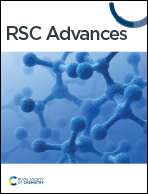Design, synthesis, molecular docking and DFT studies on novel melatonin and isatin based azole derivatives†
Abstract
In order to address the pressing demand for newer broad-spectrum antifungal medicines with enhanced activity, computer modelling was utilised to rationally develop newer antifungal azole-based drugs. Based on the drug and active sites of the Lanosterol 14 alpha-Demethylases (LAD) of the prominent fungal pathogen Candida albicans interaction, Novel triazole-linked melatonin and isatin derivatives 7a–d and 8a–d were synthesised using bioisosterism. Besides the experimental synthesis and subsequent characterization, the present study focused on obtaining optimised geometries, frequency calculations, and TD-DFT studies of the synthesised molecules. We also performed molecular docking studies to explore the inhibitory ability of the synthesised compounds against the active sites of the Lanosterol 14 alpha-Demethylases (LAD) of the prominent fungal pathogen Candida albicans. The binding interactions resulted in positive findings, demonstrating the involvement of the synthesised compounds in the suppression of fungal growth. Comparative analysis of the binding potential of the synthesised molecules and commercially available drug fluconazole revealed a remarkable note: the docking scores for the designed drugs 7b, 7c, and 8c are much greater than those of the fluconazole molecule. The in silico study of the designed series of drug molecules serves as an important guideline for further exploration in the quest for potent antifungal agents.



 Please wait while we load your content...
Please wait while we load your content...